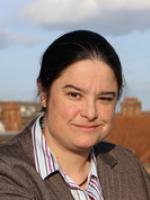
Professor of Mathematical Biology, DAMTP, University of Cambridge
David N. Moore Fellow in Mathematics, Queens' College
Current roles:
- Deputy Head of Department, DAMTP
- Vice President, Queens' College
- Director, Millennium Maths Project
- Co-lead, JUNIPER partnership
Honours and awards:
- 2023 IMA Hedy Lamarr Prize
- 2022 Weldon Memorial Prize (jointly by SPI-M-O)
- 2021 Royal Institution Christmas Co-Lecturer (with Jonathan Van Tam)
- 2020 OBE
- 2020 Honorary Membership of the Mathematical Association
- 2020 Royal Society Rosalind Franklin Award
- 2018 Vice-Chancellor's Impact Award
- 2018 Queens' teaching prize
- 2017 Whitehead Prize
- 2016 Forder Lecturer
- 2015 Pilkington Prize
- 2014 LMS popular lectures
Career:
- 2017-present Professor of Mathematical Biology
- 2013-2017 Reader in Mathematical Biology
- 2010-2012 Visiting Fellow, Ecology and Evolutionary Biology, Princeton University
- 2006-2013 University Lecturer, DAMTP, University of Cambridge
- 2006-2012 Royal Society University Research Fellowship, DAMTP, University of Cambridge
- 2004-present Official Fellow, Queens' College
- 2004-2006 Royal Society University Research Fellowship, Department of Zoology, University of Cambridge
- 2002-2004 Research Fellowship, Queens' College
Research:
Julia Gog's research is in the mathematics of infectious diseases. Recent projects include:
- Models of influenza strain dynamics
- Spatial spread of influenza
- Within-host dynamics of influenza
- In vitro dynamics of Salmonella
- Bioinformatic methods to detect RNA signals in viruses
University news items on our work
For list of publications, please try Julia's profile on Google Scholar.
Publications
How you can help with COVID-19 modelling.
– Nature reviews. Physics
(2020)
2,
274
(doi: 10.1038/s42254-020-0175-7)
Symbolic transfer entropy reveals the age structure of pandemic influenza transmission from high-volume influenza-like illness data.
– J R Soc Interface
(2020)
17,
20190628
(doi: 10.1098/rsif.2019.0628)
Contacts in context: large-scale setting-specific social mixing matrices from the BBC Pandemic project
(2020)
2020.02.16.20023754
(doi: 10.1101/2020.02.16.20023754)
Pease (1987): The evolutionary epidemiology of influenza A
– Theoretical population biology
(2020)
133,
29
(doi: 10.1016/j.tpb.2019.12.006)
A scale-free analysis of the HIV-1 genome demonstrates multiple conserved regions of structural and functional importance.
– PLoS computational biology
(2019)
15,
e1007345
(doi: 10.1371/journal.pcbi.1007345)
Symbolic transfer entropy reveals the age structure of pandemic influenza transmission from high-volume influenza-like illness data
(2019)
19005710
(doi: 10.1101/19005710)
Sparking “The BBC Four Pandemic”: Leveraging citizen science and mobile phones to model the spread of disease
(2018)
479154
(doi: 10.1101/479154)
Geographic transmission hubs of the 2009 influenza pandemic in the United States.
– Epidemics
(2018)
26,
86
(doi: 10.1016/j.epidem.2018.10.002)
Urbanization and humidity shape the intensity of influenza epidemics in U.S. cities
– Science
(2018)
362,
75
(doi: 10.1126/science.aat6030)
A new method for detecting signal regions in ordered sequences of real numbers, and application to viral genomic data
– PloS one
(2018)
13,
e0195763
(doi: 10.1371/journal.pone.0195763)
- <
- 3 of 9
